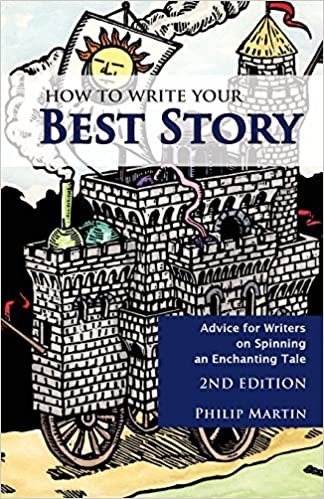Book Review: Writing Your Best Story: Advice for Writers on Spinning an Enchanting Tale
Writing Your Best Story: Advice for Writers on Spinning an Enchanting Tale, Second Edition. Philip Martin. Milwaukee, WI: Crickhollow Books, November 15, 2017, Trade Paperback and E-book, 168 pp.
Reviewed by Lisa Lickel.
Philip Martin has written a book that shows, rather than tells, authors how to create a good story by framing his techniques against one of his own stories.
Story should rise above narrative, Martin writes; more than groups of words, more than a series of events. Telling a story is also an art form. Quoting liberally from ancient to modern works, Martin employs his background as a professional gatherer of stories and histories to show how story works across culture and time to draw listeners in to a communal experience. Writers are more than purveyors of phrases. Writers offer a promise and provide a worthwhile payoff.
As an experienced editor of advice books for writers, a former editor for best-selling, mainstream authors, and the director of Great Lakes Literary, Martin shares his advice and techniques for creating memorable works that attract agents and editors. He takes a three-pronged approach, and so this book is divided into sections. Start with a quirky hook; keep the middle more than readable by using delicious details; and finally, provide a satisfying ending.
Martin is not a fan of plot. Plot, as a mechanism for writing a book, will make your work mechanical, contrived, agenda-driven, and unimaginative. His emphatic dissing of the term throughout the book is actually a rebellion against formula-writing. Martin teaches that stories need structure, whether an author uses it for a flexible framework around which to build a tale, or discovers it after the story is complete. Structure works to create commonality or shared experience. Too many authors use plot as a controlled formula, which Martin insists must be avoided.
Whether cyclic, arced, or linear, a story has a beginning, middle, and an end. It’s the promise of a fine meal initiated and fulfilled. Start with a desire or a want. Bait your hook with enticing morsels. Help the reader invest. Establish resonating characters in intriguing environments. Give them a problem to work on. Create anticipation and offer satisfying surprises. “Delightful details” keep the reader’s interest and should build upon the premise. “Detail should triumph plot,” Martin says. Even while he dismisses plot, Martin embraces theme. “Theme should tell you what the ending should deal with,” he writes. Don’t try to find it until you’re well into your story. Theme is a message that answers why the story is important. The end of your tale should let the reader know this journey has been worthwhile, that he has returned better for having taken it with you, the story teller.
The book is well written with an easy-to-appreciate style. As mentioned above, he spins a story to show us how to create interesting characters with interesting problems who need interesting solutions to achieve desired outcomes. Martin also shares examples from well-known work to illustrate his points. While geared specifically to writers, those who practice oral story-telling would certainly benefit from reading and studying Writing Your Best Story. The premises and examples Martin lays out in the book apply to all kinds of writing, from short story to full length novel, and even on a certain level to non-fiction. A full quotation source list and recommendation to read the original material in context is included.

